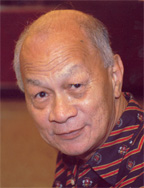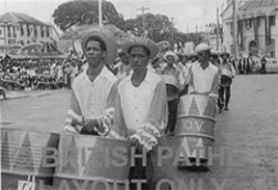By Godfrey Chin

Steelband has been the essence of our Caribbean Carnival/ Mash/Crop-Over celebrations since this phenomenon emerg-ed after WWII, and remains a unique musical art form in the twentieth century, with efforts from Japan to Sweden usurping this contribution from our tropics. Like our own Demerara rum and sugar, we need to propogate, preserve and defend steelband in the Caribbean – especially since our vaunted WI cricket prestige is currently on the wane and in limbo.
Steelband started in Port of Spain during their VJ celebrations in September 1945, following the temporary wartime ban on ‘jump up’ on the streets. The local musical instruments ‘tamboo bamboo’ stored temporarily under bottom houses were taken to the streets, but burst from recent disuse. Bottle and spoon, shack-shack, rubbish-bin covers and lard cans were brought out to provide the cacophonous din for the celebratory street tramps. In a few short years the island pioneers – Ellie Mannette, Spree Simon, Neville Jules, etc, pioneered a galaxy range of pan instruments from discarded 45-gallon drums at the US Chaguaramas Base, and the steelband was born.
By 1947, the Trinidad band Red Army arrived in Georgetown by schooner, and made an impressive appearance. The nylon goes that at a dance performance at BGCC, there was a huge scuffle near the stage. When order was restored a first pan was missing. I have never been able to corroborate this story, but must admire that even before 1950 our natives were demonstrating enterprise and resourcefulness.

By 1953 local bands sprouted throughout the mudland from Bartica to NA, and these included Quo Vadis (at Robb St off Bourda Market); Invaders (Federation Yard, Regent and Wellington); Pagans; Chicago; Sun Valley; Casablanca – all defending our ‘steelbandship’ against boasting, bragging Trinidadians, in regular competitions.
I must mention here the initiation of a young Roy Geddes into pan in Casablanca, a panyard at High and Harel Streets. Roy mastered every facet of the steelband – playing, tuning, arranging, and formed the Silvertones in 1964. He is today a revered icon, who after 56 years is the grand professor of pan in Guyana. His Steelband Museum in Roxanne Burnham Gardens is a shrine, and he received the Medal of Honour in 1971 and the Arrow of Achievement in 1996 for his commitment and dedication.
Our top Road Band for Queen Elizabeth’s coronation, June 1953 was Quo Vadis, which played that Christmas a Roman ‘mas’ and assumed the name from the MGM Roman epic, which opened at the Astor. I remember Cedric Williams (Pemya) spending long hours heating/tuning pan under the huge samaan trees on Bourda Green with Woodman Ellis the arranger.

Pemya was also a good calypsonian, a polished boxer and talented costumer, and his street corner cook-up was a nightly sell-out.
Quo Vadis’s main competitor was the Invaders, where Dan Sandiford and later Patsy and Calvin Whyte plus Carl Bledman and Barney Johnson contributed to their success. Our annual big event then was the Christmas steelband tramps, in colourful costumes. Expenses were met by the mas players themselves, with some sponsors’ pittances for carrying advertising pickets, plus generous tin-cup donations from citizens as the bands tramped passed in appreciation for them sharing and spreading the Christmas festive spirit. The masquerade bands with fife and drums, plus a galaxy of flouncers, mad bulls and Mother Sallies added to our holiday delights. Those were the days my friends… bacchanalian times at Christmas, when even dem church girls participated. We feted like Vikings. Ya think it easy?
Christmas 1955, Quo Vadis mas was Robin Hood; the Invaders played for the USS Forestal sailors on leave; and the Casablanca, fancy sailors. At least a dozen costume bands met at St George’s for a ‘dedication mass’ presided over by Barney Johnson, dressed as the Archbishop of Canterbury. The church was a panoply of wall-to-wall costumed steelband enthusiasts – a Hollywood spectacle to match any De Mille extravaganza.
The next year 1956 Quo Vadis split, with Pemya bringing out Marabuntas at the same corner – Robb St end – with a splendid depiction of Audie Murphy’s To Hell and Back, while Quo Vadis played pirates and buccaneers. The Christmas tramps were our holiday delight, even though the middle class parents scoffed at our tramping on the streets with ‘dem hooligans.’ Mine was convinced that my gallivanting at every opportunity in the steelband tenement yards would lead me to a sojourn at Onderneeming Boys School, a cell at Camp St Lot 12, or a distinguished career driving donkey cart. Like sawdust in the bones, the steelband music was as infectious as a new-born pickney, and a road tramp was more enjoyable than a Buxton spice mango.
Steelbands became popular and acceptable by the sixties, thanks to Sterling Bettencourt’s Ping Pong Lullaby/Melody, and the Katzenjammers mono recordings played daily on Radio Demerara. Ayube Hamid encouraged and recorded the bands for radio broadcast sessions. Stage bands became popular with Charwyn Burnham’s Texacans ruling the roost. Quo Vadis featured in midweek, midday concerts in 1957 at St Andrews, as Georgetowners became afflicted with the rhythm of the steel band.
Christmas Eve 1957, the first ‘Putagee steelband’ organized by Bunny and Peter Fernandes, the Ramblers’ Serrao Bros, and Vic Gonsalves came out from John Fernandes Wharf, Water Street. What a commotion with all the commercial downtown workers tramping down Water Street in convict costumes I had produced. Christmas morning I got some material from Yong Kong’s Haberdashery at Cummings and Middle Street, disturbing their breakfast, and by noon had joined the Marabuntas playing Sputnik Space mas. New Year’s Day the local Chinese would hire a steel band, rope off their group, and tramp from the Lee’s residence High and Hadfield streets. Ya think it easy!
Guyana’s Music Festival started in the late fifties with steelbands featuring the Pelicans, Kaietuckians and Metronomes, plus the road bands stage sides vying in national competitions. At this time pan in school was introduced by Lynette Dolphin and Derrick Jeffrey and the golden age of steelband, emerged in the late fifties. The emergence of the string bands was evident at this time, as the popular brass bands of Tom Charles’s Syncopators, Al Seales’s Washboards and Nello Luckies, etc, had been depleted as the talented Police Band musicians were debarred from moonlighting. The steelbands, however, more than held their own against the popular string groups of the Rhythmaires, Combo Seven, Telstars, Dominators, and Chet and the Diamonds.
Princess Margaret’s visit in 1958 was the next big occasion for the local steelbands, with the Invaders, Quo Vadis and Casablanca delighting the royal visitors, dignitaries and spectators with portrayals of circus clowns, slave rebels, fancy sailors and American Indians.
The local Jaycees added impetus to the steelband movement with their annual festivals from 1960 to 1962 – massive parades of costume bands and floats at Eve Leary, plus nightly stage presentations at BGCC with the crowning of festival and calypso monarchs.
Costumed Band of the year winners were 1960 – Bunny and Peter Fernandes ‘Political Situation’; 1961 Invaders, ‘Sioux Uprising’; and 1962, Godfrey’s ‘Shell’s Circus Spectacular.’ My Helen of Troy floats won the lion’s share of the float parades. Unfortunately due to the political unrest of the early sixties the Guyana Festival petered out.
By Independence 1966, steelbands had become stronger. Atlantic Symphony founded by Rudy Bishop and Desmond Fraser off the Kitty foreshore rivalled Geddes’ Silvertones for Road and Music Festival titles. Major corporations, such as Banks DIH, Chronicle, Demba, Esso, Shell and Demtoco offered generous sponsorship. The Independence Parade on North Road – eastward past the grandstand on Merriman’s Mall off Bourda Market – was a highlight only surpassed by our Independence flag-raising at the National Park and Mount Ayanganna simultaneously. Thousands of Guyanese celebrated our Independence dancing, jigging, gyrating, jumping and waving in the streets with frenzied abandon.
In 1968 the Jaycees of McKenzie introduced Mash in the mining town, and steelbands’ popularity peaked. Evadne Gravesande won Mash Queen in my ‘Egyptian Brooch’ costume, and drove off in a brand new Morris Minor. The Linden Highway opened in December 1968 permitting Georgetowners to drive up there for the ’69 celebrations. And what a party it was.
In 1970 as Guyana became a republic Mashramani was so popular that it was adopted as a true cooperative celebration of achievement, and thus became our annual Republic celebration.
I must mention here some most valuable contributors to our steelband movement – some will be watching from up there waiting for another ‘big tramp.’ They include Charlie Hubbard, Ayube Hamid, Lynette Dolphin, Barney Johnson, Carl Bledman, Reggie Simpson, Noel and Iris Leitch, Bunny Fernandes and Basil Hinds. I must not leave out Pluto Martindale, Roy Geddes, Hammie Green, Neil Chan, Bertram Devarel, Rudy Bishop, David Lanyi, Carlotta and Ken Croal, the Griffith Brothers, Patsy, Calvin Whyte and Derrick Jeffrey; they were all contributors to our steelband legacy.









